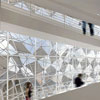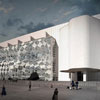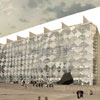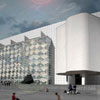Adaptive Architecture, Building Facades Concept, Conceptual Architectural Design, Images
Responsive Building Skin Systems
Building Skin Tailoring Project – design by Sushant Verma & Pradeep Devadass
17 Jul 2013
Building Skin Proposal
Design: Sushant Verma & Pradeep Devadass – Founders of rat[LAB] – Research in Architecture & Technology (www.rat-lab.org)
Adaptive Architecture
This is a novel project where a material system is developed at an architectural scale, which has not been explored much in the past, in the domain of adaptive architecture. It deals with the idea of energy-efficiency (and hence sustainability), with dynamism and kinetics.
‘Adaptive Skins’
Research has been done from 2011 to 2013.
Adaptive Skins received the prestigious MAK Schindler Scholarship to develop the full scale prototypes in Los Angeles next year, with industry collaborations. Research papers based on this project have also been selected in eCAADe (Portugal – PUBLISHED), CAADRIA (Singapore), ASCAAD (Jeddah – PROCESS OF PUBLICATION), EG-ICE (Vienna – PUBLISHED) & CAADFutures (Shanghai).
Here is a summary (abstract) of the Adaptive Skins project:
The project investigates responsive building skin systems that adapt to the dynamic environmental conditions to regulate the internal conditions in a habitable space over different periods of time by exhibiting a state of motion and dynamism. Heat and Light are the primary parameters for regulation, leading to energy efficiency and dynamic spatial effects.
Passive and active skins using shape memory alloys and pneumatic actuators are developed through investigations of smart systems that integrate smart materials and smart geometries. The precedents in this domain have rarely dealt with individually controlled multiple parameters of heat and light in a single system, which is attempted in this project. Owing to the complexity of the multi-parametric system, genetic algorithms are developed for system optimization and calibrated with physical prototypes at varied scales.
The developed systems are tested against two distinct climatic models- New Delhi and Barcelona, and evaluated for performance, based on heat and light, which are quantified as solar gain and illuminance as principles, and daylight factor for evaluation purpose. The use of genetic algorithms makes the problem solving faster and accurate. New tool-sets are developed in the process by combining various digital tools, to create a real-time feedback and memory loop system.
Adaptive Architecture Designs
1. Domain
Adaptive Skins design concept by Sushant Verma, Zaha Hadid Architects, London, UK:



images from architect
Our lives are surrounded by constantly changing forces of nature and environment. Everything is in a constant state of flux, with varying degrees of dynamism. Our lives too, are always in motion. The spaces we inhabit are constantly changing as well, although the change is slow and occurs through non-physical conditions.
The physical state of the inhabitable spaces are more or less constant and not in motion. A building envelope consists of vertical (facade) and horizontal (roof) components which protects the building from direct external environment and helps in maintaining comfortable interiors along with providing structure and stability to the building. A traditional building skin thus provides stability, regulates air pressure (fenestrations) and protects the interiors from direct environmental factors (sunlight, rain and wind).
Building skins are a vital component to resolve the issues of responsive architecture as they are a medium through which the intelligence can be imparted to the building system to respond to an environmental stimulus. Thus key characteristic of an effective intelligent building skin is its ability to modify energy flows through the building envelope by regulation, enhancement, attenuation, rejection or entrapment.
The project adaptive [skins] questions the static nature of architectural spaces, and engenders dynamism and motion in architecture in a complex and dynamic environment. The line of research is responsive and dynamic architecture, where developments and advancements have been made in the past, dealing with dynamism and kinetics in architecture.
However, a major setback in the current precedents lies in the use of mechanical control to create dynamism, which in most cases, is only for spatial effects and aesthetics. An attempt has been made in the research to deal with a bigger issue, for creating dynamism and response, for dealing with multiple environmental parameters which affect the internal conditions and energy efficiency. Also, there is an attempt to embed material intelligence into the system, to rule over the use of mechanical control, partially or completely. The use of two parameters – heat and light is very critical in the research, being individually controlled in a single system, as the issue becomes complex and requires efficient use of computation for problem-solving.
1.1 Adaptive Architecture
“Adaptation is the evolutionary process whereby a population becomes better suited to its habitat.
– This process takes place over many generations, and is one of the basic phenomena of biology.”(Charles Darwin, p1959).
– The term ‘adaptation’ is commonly used in architecture in relation to the changing morphologies of the architectural artefact.
– These changing morphologies have been a result of timely changes and evolution of architecture as a social entity, technological product and as a practice.
– rough years of architectural evolution, changes have occurred in notions of how buildings are conceived and built. The architectural morphologies adapt to the time, in which they are conceived and realized. These adaptive morphologies are a resultant of changing times, social form, economic support, user needs and environmental effects.
– The environmental changes that occur in a given time, such as a day, can be a constant force of changes that need to occur in an architectural object, leading to local adaptations.
– The global climatic change, occurring over a course of time, creates forces for architectural object to change over the years, in order to survive and sustain itself. Adaptation in architecture is a long-term process that occurs with time and generations, where improvements in the technology, economic support as well as human thought-process, contribute to the adaptive response.
Adaptive Skins concept by Sushant Verma, Zaha Hadid Architects:



images from architect
Th e etymology of the word adapt stems from the Latin adapto, from ad (“to, towards, at”) + apto (“adjust, adapt; prepare”). In simple terms, adapt means to “adjust toward.” The idea of adaptive architecture is misused in today’s time in a number of projects that aim to be adaptive but contribute only a small step towards the long-term adaptation that may or may not occur, by solely a single project.
Adaptation occurs through generations, with constant improvements, a feedback evaluations, and survival of the fittest, based on certain fitness criteria. A lot of projects that are trying to deal with adaptation fall under the category of interactive, dynamic, kinetic or responsive architecture. These are closely related domains within architecture that may or may not contribute to adaptation in the long run. An intelligent pre-programmed mechanism of response and feedback is to be embedded in architecture, with a real-time response and improvisation, for it to be termed adaptive. It is a complex phenomenon with a multi- layered non-linear process.
Adaptive Skins Architecture images / information received from Sushant Verma at Zaha Hadid Architects
Location: London, England, UK
Architectural Concept Designs
Wave Tower Design

picture from architect
Hanging Tower

image © Stephan Sobl
Metropolitan Vertical Theme Park

picture from architect
Comments / photos for the Adaptive Skins – Conceptual Architecture page welcome
Website: adaptiveskins.com
